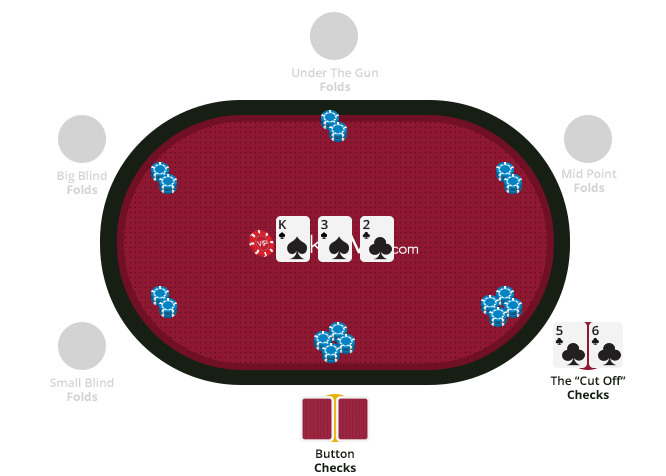Many small stakes poker players face similar challenges. In order to over come hardships at the tables, it is good idea to strip your poker game bare and return to the foundations. It will be worth your while.
Part 1 of this article dealt more with general concepts of beating small stakes full ring tables; things like proper hand selection, minding your position and other ground rules to set you on the right path. Part 2 goes one step deeper and deals mostly with betting tendencies and frequencies.
Facing 3 Bets in Small Stakes Poker
I'm going to

start off with the 3 bet game as it's probably what is costing beginner players the most from their win rate once they understand what cards they should be playing from each position.
Following on with our theme of going back to basics and keeping it simple, we can take a look at how to approach the problem of not wanting to get run over by aggressive players, but also not to start defending too liberally, which can be a lot more costly than taking the passive stance of folding enough where it becomes possible to exploit us by
3 betting any two cards. At the smallest micro stakes we will only ever see a handful of players who will be looking to exploit us in this manner.
On average, in a full ring game, 3 betting frequencies are far below what you will see in 6 max. If we don't understand the dangers of playing post flop against such a tight range with "pretty" hands such as 87s or A3s we can start losing money unnecessarily, for no reason other than we don't want to fold too much because the villain might be bluffing.
So, if we are resigned to having to play extremely tight as regards to defending by calling, what can we do by making a
4 bet bluff?
Assuming normal bet sizes, when we 4 bet bluff, we need villain to fold in the region of 60% of the time to break even. So we are now in a situation when facing much of the player pool where it is difficult to defend by calling, and the maths behind 4 bet bluffing shows that we can't re-raise either. So what to do?
I've played around 6-7 million hands of FR Zoom over the last 3 years, and have found that set mining in 2-5NL Fr Zoom is profitable in position and out of position as well. I can't be sure exactly how wide villains 3 bet range needs to be before we must stop calling pairs for set value, but I tend to switch to 4 bet bluffing from set mining when Holdem Manager 2 shows villain 3 betting more than about 7-9% from that particular position.
If we are facing a player 3 betting around 10% from the blinds when we steal from the button, we can look to add KQs and AJs to our calling range
This is mostly applicable when we are opening from the
hijack or later. If we open from the first four seats in a micro stakes full ring game, we can be sure the vast majority of the time villains range is tight enough to set mine.
This leaves us with working out which non pocket pair hands to call with. I really recommend nothing other than AK and AQ to keep in with the philosophy of these articles, unless we are on the button. If we are facing a player 3 betting around 10% from the blinds when we steal from the button, we can look to add KQs and AJs to our calling range, and increase our 4 bet frequency.
There are other hands you can defend by calling with, but if we don't have the post flops skills to match our ambition, trouble awaits.
Following what I have suggested here will lead to a fold to 3 bet stat of slightly less than 65%, which is a great starting point.
To end this part on facing 3 bets, I want to make clear a point I see many players unaware of, every day that I play. Just because a player is 3 betting a huge amount, we will still only ever see him 5 bet shoving QQ+ and AK at his widest most of the time. 5 bet bluffing at 5NL or below is extremely rare.
This means, assuming normal bet sizes and 100bb starting stacks, that we *
CAN NOT* 4 bet and call a shove with either QQ or AK *
IF* villain is only ever 5 bet shoving QQ+ and AK, as we only have about 40%
equity versus that tight range. Even with the dead money already in the pot we will still end up losing over the long run.
3 Betting for value in Small Stakes Poker
Here when I specify "for value", I mean that we intend to 5 bet shove when facing a 4 bet.
This can be very tricky for players new to the game, or recreational players that are yet to spend some time examining how equity affects our decisions in re-raised pots pre flop.
As I mentioned in
Part One of this article as an example, there are many players who will not stack off with anything other than AA pre flop for 100bb, and there are many more who will only stack off KK+. If we are dealt KK and try to get the money in preflop, against a range of QQ+,AK, we expect to win 57% of the time. Not a bad result. If, however, villain only stacks off KK+ , then we expect to win 22% of the time. A complete disaster.
To avoid this situation

I want to suggest that we don't 3 bet tight players who are opening from the first three seats with anything other than AA. By calling preflop with KK we keep villains range as wide as possible. The downside to this strategy is that we can end up in a pot with many players when we have a hand which prefers a HU pot, but that shouldn't be too much of a worry.
Also, there is no need to worry at these stakes about any regs working that you always have AA when you 3 bet EP open raises from them. In a few paragraphs I will explain a bit about 3 betting for "pseudo" value, where we start re-raising players with certain characteristics for value with a hand that we definitely don't want to stack off with. These extra 3 bets will make your 3 bet vs EP stat appear wider than what it really is in a standard situation vs a reg.
When it comes to late position opens and 3 betting, however, you need to be able to understand the information supplied by your
HUD, without over relying on tiny sample sizes, and what you have witnessed in recent hands. There isn't room here to discuss an entire 3 betting strategy as the aggressor, but I still want to make some points to help keep it simple, which isn't easy at all once ranges start to get wider. This is one of reasons 6 Max can be a lot tougher to get to grips with.
As discussed above, nearly all the players 3 betting wide from late position and the blinds, are only 5 betting QQ+ and AK at most, but in my experience you will see KK+ most often. This is the approach we should take if we are not being exploited, and believe me we aren't 99% of the time. You should still be 3 betting LP opens with your premium holdings as you will be called by dominated hands, giving you a highly profitable situation post flop. But for now, to keep it simple, we shouldn't be looking to 5 bet shove any wider than KK+ unless we have a clear reason to.
You should still be 3 betting LP opens with your premium holdings as you will be called by dominated hands, giving you a highly profitable situation post flop.
3 Betting for "pseudo" Value in Small Stakes Poker
This is where we take another step down the rabbit hole. When we engage in 3 betting for pseudo value, we are doing it for a specific reason against a specific player because we have information leading us to expect that villain will react in a predictable manner a decent amount of the time.
Let's say we see a villain open with a wider than average range, and it folds to us on the button with JJ, this would normally be a standard call, but we notice that villain has never 4 bet over a 2000 hand sample, and has a fold to 3 bet stat of only 20%. Now we can make an adjustment here and 3 bet for value because of our read.
It's always a judgement call how wide we can go with this, but in keeping with this article's philosophy I want to suggest we only start off with hands such as AQ, AJs, JJ, TT, KQs, when we are targeting players who will call out of position with dominated hands.
It's important when we do this with hands that make perfectly good calls preflop, and we get 4 bet, that we keep good discipline and fold. Never get frustrated that a good hand has effectively been turned into a bluff, if the read was correct that villain really does defend against 3 bets to liberally then you still made the right play, and will make better profit over the long run than if you had only cold called.
3 Betting in Small Stakes Poker - Round Up
Mastering 3 bet pots will be the first large step towards crushing the micros and moving towards small stakes. There is so much opportunity for increasing our win rates compared to single raised pots. As we move up the stakes ladder we see a lot less spots for pseudo value, and we will also have to maximise our card spread as regards what hands do we 3 bet versus cold call. But this is all for the future, for now just avoid getting yourself into trouble and aim for a 3 bet stat between 3-4%, at the lower end if you're not confident post flop in re raised pots.
I recommend once you have your game stabilised and your win rate is on the way up that 3 bet pots is the first thing you look at in depth. There is a good series on this website which is linked below.
Set mining and cold calling in general
In today's games set mining is not

close to as profitable as it was a few years ago. Now it comes under the heading of "
redline game" for a lot of players if they call versus a single player. I have found over a large sample that unless the pot was already multiway cold calling 22-66 was losing me money in every seat apart from the big blind, and from all seats if I called versus an open from the first 3 seats.
So I recommend folding 22-66 unless the pot is already multiway. If there are 3-4 players already in the pot and the open came from early position then go ahead and call as well.
As for unpaired hands, in position unless we have a concrete reason to 3 bet then AK, AQ, AJs, KQs are fine calls versus a standard hijack range of around 15% or wider.
Once we get down to the smaller suited connectors like 54s it's not enough to call and just fold to a c bet if we missed the flop entirely, we need to be proactive with our "redline" game to attempt to take the pot away. Again this is something which can get us into trouble if we don't have a clear plan which we know is a positive expectation play, so it is best for now to just stick with the high card hands suggested above.
Small Stakes Poker Variance
Even though I started with poker way back in 2005, it wasn't until I switched to the fast fold format that I started to see a true picture of how harsh the variance can be. As far as cash games go, 9 handed NL Holdem is the least swingy of your choices for games regularly available. But even so, I have had a stretch pushing 9bb/100 for about 400K hands, I have also had close to 300K hands winning at 1.4bb/100. All for an average win rate of about 6bb/100
This should give you some idea of how long the bad spells can last. It's so important not to let your head drop if you give this philosophy a go. What can start off as bad variance can lead on to poor play and quickly snowball out of control. If you have a full time job and don't have the time to play a large amount of volume then this can clearly go on for a long time.
It's important to recognise that this is a part of the game which is never going to go away, you have to tough it out and it's how we deal with this which can separate those players who are looking to make a fast buck, from those who love the game for what it is. It is the latter who come through the tough times as better players and make the best use of their potential.
Conclusion
I know I said I was going to cover Holdem Manager analysis but once I looked it really seemed too involved to be a side issue on an article about learning to beat the games for the first time. I'll look to make a separate article as a beginners guide to database analysis later on.
And remember this if you remember nothing else from anything I have written, if you really feel you are in a tough spot faced with what you think is a very close decision, then taking the safe option of folding is likely not really going to cost you much profit. Close spots are close because they only offer thin value and are difficult to judge. This is why better players can make such high
win rates when they drop down a couple of stake levels, because they see such more in depth and can capitalize much more efficiently on the smaller profit opportunities.
Take things one step at a time, and try and work on one aspect of your game at a time. Treat it like studying for an exam, ask yourself questions about how to approach a situation, if you can't come up with a clear answer you need to be proactive and find out, then expand on that and look deeper.
When we learn new concepts it can be difficult to implement them into our game. I think the key is to make sure you understand it well enough to be able to teach somebody else, that way it must all be clear in your mind, and if it isn't you need to go back and learn more.Otherwise the hours you have spent previously looking at this concept will have essentially been wasted because you haven't crossed that boundary where it is all clear enough to implement into your game where you can see the results.
Take things one step at a time, and try and work on one aspect of your game at a time.
I hope my experiences have translated into something useful for those of you who are struggling, and I wish you all good luck at the tables in the future.
Mark
 start off with the 3 bet game as it's probably what is costing beginner players the most from their win rate once they understand what cards they should be playing from each position.
start off with the 3 bet game as it's probably what is costing beginner players the most from their win rate once they understand what cards they should be playing from each position. close to as profitable as it was a few years ago. Now it comes under the heading of "redline game" for a lot of players if they call versus a single player. I have found over a large sample that unless the pot was already multiway cold calling 22-66 was losing me money in every seat apart from the big blind, and from all seats if I called versus an open from the first 3 seats.
close to as profitable as it was a few years ago. Now it comes under the heading of "redline game" for a lot of players if they call versus a single player. I have found over a large sample that unless the pot was already multiway cold calling 22-66 was losing me money in every seat apart from the big blind, and from all seats if I called versus an open from the first 3 seats.

